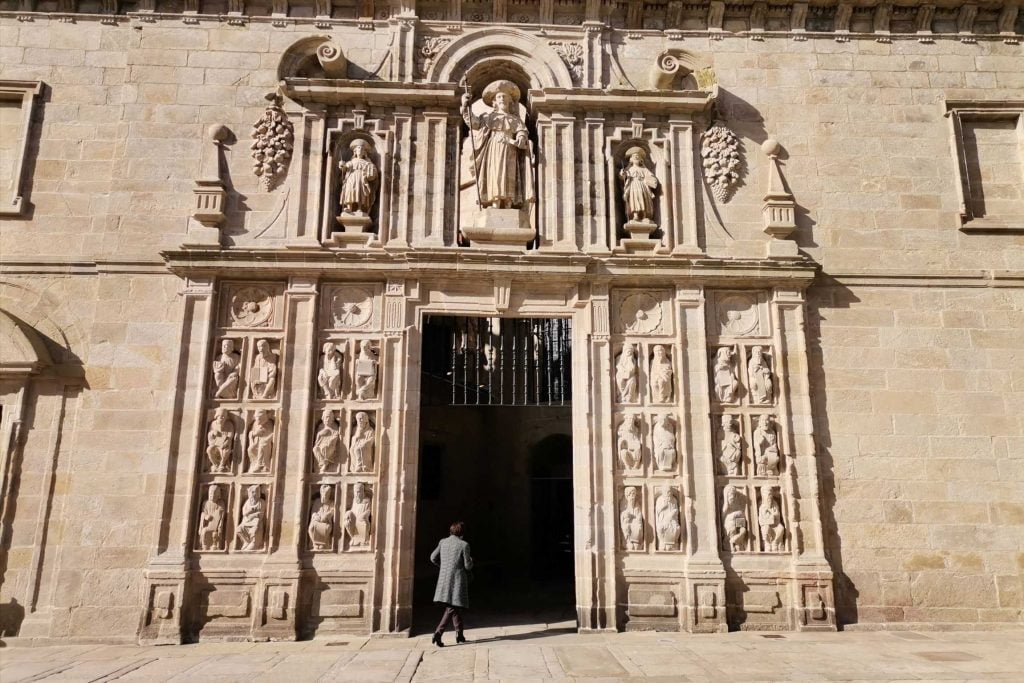The Porta Santa or Holy Door in Santiago de Compostela is a special entrance to Santiago de Compostela Cathedral that is only open to pilgrims during Holy Years, known as Ano Xacobeo or Jubilee Year. The Porta Santa is located on the wonderful Praza da Quintana.
The Holy Door in Santiago de Compostela takes pilgrims straight to the back of the main altar in the Cathedral and the crypt where the remains of Saint James the Apostle are kept.

The wonderful door is flanked by the figures of 24 magnificent ‘doormen’, which are sculptures by Mestre Mateo dating back to the 12th-century. They were previously located in the stone choir, which used to be at the centre of the Cathedral for many years. From up above, Saint James the pilgrim is looking down with his two disciples alongside him.
It also used to be known as the Door of Forgiveness, Puerta del Perdon.
There is also a Puerta del Perdon in Villafranca del Bierzo, which allows pilgrims to achieve their indulgence if they are suffering from health problems and can’t continue their journey to Santiago de Compostela.
HOLY YEARS
A Holy Year on the Camino de Santiago or Ano Xacobeo only takes place every 6, 5, 6 and 11 years, when the Feast of Saint James, which is the 25th of July, falls on a Sunday.
2021 is a Holy Year which has been extended until 2022 due to the pandemic, which means the Porta Santa entrance will be open to pilgrims arriving in Santiago de Compostela until December 2022.
Walking through the Holy Door in Santiago de Compostela is a special experience for pilgrims that are awarded plenary indulgence, or absolution for all their sins. To obtain this plenary indulgence they must also go to confession, receive the communion and offer a prayer.
OPENING OF THE PORTA SANTA
The opening ceremony of the Porta Santa generally takes place the last day of the year before the Xacobeo is due to commence, with pilgrims and church authorities taking part.
The sealed wall that blocks the Holy Door is knocked with a silver hammer by the Archbishop of Santiago who will be the first person to cross the door and clean it with holy water and olive branches.
When the Holy Year ends, the Porta Santa will be sealed again until the next Xacobeo year.
ORIGINS OF THE HOLY DOOR
Despite Holy Years or Jubilees taking place as far back as the 12th century, it wasn’t until the 16th century that Holy Doors were built in the Roman Basilicas of Saint Peter, Saint Paul outside the Walls and Saint Mary Major, as well as in Santa Maria di Collemaggio and Assunta di Atri in Italy, the Cathedral of Santiago de Compostela and the Cathedral of Notre-Dame in Quebec, Canada.
The Holy Door is a symbol of renewal, as well as journey towards salvation based on the words of Jesus, who said: “I am the gate: Whoever enters through me will be saved.” – John’s Gospel.
At JWT we have a schedule of Camino guided tours as well as a fantastic selection of self guided tours on the best Camino de Santiago routes. Whether you are travelling on your own or looking to join or organise a group trip, our travel experts can help you decide which Camino route and tour would be the best for you.
If you would like to join our Camino de Santiago guided tours, need assistance planning your self guided Camino adventure or would like to organise a group trip on the Camino, contact our experienced travel team for advice.
Contact Us



